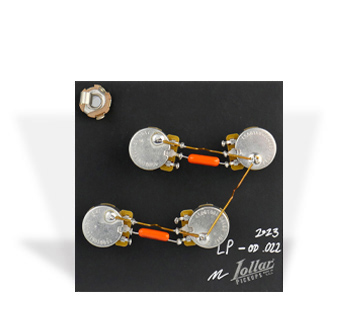

El Rayo Humbucker
Item #: 10-406-1
Optional Add-Ons
Product Details
With excellent note clarity for a humbucker, we often describe the dynamics of the El Rayo® as having a percussive quality almost like a single-coil pickup. The entire frequency response is relatively flat, with increased note bloom and less compression than a typical P.A.F.-style humbucker.
Avg. DC: Neck 3.5K, Bridge 4.0K (Read about DC resistance)
Recommended Potentiometers: 500k
Recommended Capacitor: 0.022μF

'50s-style Pre-wired Kit for Les Pauls
Upgrading the electronics in a Les Paul® yourself couldn’t be easier than it is with our Lollar Pre-wired Kits. The kits are hand-wired in our shop and meet Jason Lollar’s preferred specifications. This kit can be used in just about any Les Paul equipped with two pickups that each have their own volume and tone controls.
Whether you’re installing new pickups and want high-quality electronics to go with them, or you want to upgrade the stock electronics in your Les Paul®, our pre-wired kits are a great option. We’ve done most of the work so all that’s left for you to do is install the kit in your guitar and solder in your pickups, output jack and switch.
Pickup Dimensions

Lollar El Rayo Humbucker Pickups
All El Rayo sound files played with a Collings CL Deluxe. Clean files through a Fender Pro Reverb. Dirty Files through a Dr. Z Maz 18.
El Rayo Humbuckers—Your Questions Answered
What They Are Saying
Standard Covers

Nickel

Chrome

Gold

Black Chrome

Lightly-aged Nickel

Lightly-Aged Chrome

Lightly-Aged Gold

Uncovered Double Black

Uncovered Zebra

Uncovered Reversed Zebra

Satin Gold

Satin Nickel

No-hole Nickel

No-hole Chrome

No-hole Gold

No-hole Black Chrome

No-hole Lightly-aged Nickel

No-hole Lightly-aged Chrome

No-hole Lightly-aged Gold

No-hole Satin Gold

No-hole Satin Nickel
Colors shown here may vary slightly from actual colors due to differences in computer monitors.
Made-to-Order Covers

Choose any combination of Cover Ring and Top shown below.
NOTE: Pickups with Made-to-Order covers may require additional time to build and fulfill.

Chrome/Tortoise

Chrome/Pearl

Chrome/White

Chrome/Matte Black

Chrome/Gloss Black

Chrome/Parchment

Chrome/Cream

Nickel/Tortoise

Nickel/Pearl

Nickel/White

Nickel/Matte Black

Nickel/Gloss Black

Nickel/Parchment

Nickel/Cream

Gold/Tortoise

Gold/Pearl

Gold/White

Gold/Matte Black

Gold/Gloss Black

Gold/Parchment

Gold/Cream

Black Chrome/Tortoise

Black Chrome/Pearl

Black Chrome/White

Black Chrome/Matte Black

Black Chrome/Gloss Black

Black Chrome/Parchment

Black Chrome/Cream
Colors shown here may vary slightly from actual colors due to differences in computer monitors.
Frequently Asked Questions
Is there a sound difference between pickups with covers and without?
Metal covers can have some effect on tone, though it is often subtle. The metal parts can attenuate some of the highs, meaning that covered pickups will be a touch darker and warmer. Uncovered pickups are a bit more bright or focused.
Note that we do not recommend removing your covers to compare the difference. Breaking the solder joint that attaches the cover will void your warranty.
What’s the deal with single versus four-conductor pickups?
Single conductor leads have a hot lead inside a braided metal exterior, which functions as ground. Single conductor wiring is appropriate for traditional Les Paul-style wiring with a three-way switch and separate volume & tone controls for each pickup.
Four-conductor wiring gives each of the humbucker’s two coils their own leads. This enables you to take advantage of more complex switching like in/out of phase, series/parallel, or coil splitting. If your guitar has extra mini-switches or push/pull pots for these options, you’re likely going to want four conductor.
Can I get unpotted pickups?
Though most manufacturers did not wax pot their pickups in the 1950s and 60s, we choose to pot our pickups because of the strength and stability it adds to the coil. We frequently see coils shifting in vintage and modern unpotted pickups which often leads to the need of costly repair or outright replacement. We feel that the added stability and protection of the coil outweighs any perceived improvement in tone.
What values of potentiometers and capacitors do you recommend for humbucking pickups?
The most common/traditional choices are 500k pots (both volume and tone) and .022μF caps—and these are the values we typically recommend. That said, there are no hard and fast rules. You can read more about how different pot and cap values affect tone in this two-part blog post: Part I - Pots, Part II - Caps.
How far from my strings should I set my El Rayo pickups?
Generally, as close to the strings as possible while avoiding picking hand interference or magnetic pull.
Do I need F-spaced pickups?
F-spacing means that the pole pieces are slightly further apart so that they’ll line up better with the pole pieces on guitars with Strat or Tele-style bridges. The best thing you can do to be sure is to measure your string spacing at the bridge – approximately 53mm between the 1st and 6th strings is typical for F-Spacing. Regular humbucker spacing is closer to 50mm. If you have F-spacing, we offer an F-Spaced El Rayo, and several of our other humbucker models also offer F-spaced versions..
F-spacing is really only important at the bridge, where the strings are further apart. As they taper toward the nut, your neck pickup should be fine with regular pole piece spacing.
Our F-spaced pickups use four-conductor leads by default, which can be wired like a single conductor by insulating the red to white leads and green lead to ground.
Which way do I orient my humbuckers during installation?
The conventional orientation is with the screw sides of each pickup on the outside (closest to the bridge and fingerboard).





